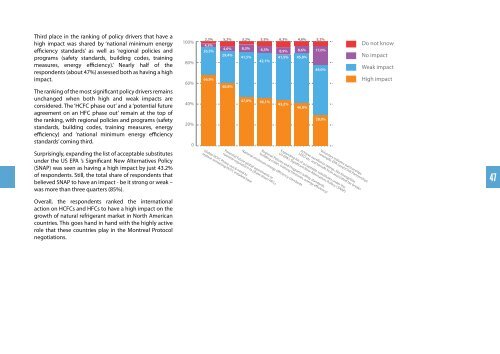TABLE OF CONTENTS - Everything R744
TABLE OF CONTENTS - Everything R744
TABLE OF CONTENTS - Everything R744
Create successful ePaper yourself
Turn your PDF publications into a flip-book with our unique Google optimized e-Paper software.
Third place in the ranking of policy drivers that have a<br />
high impact was shared by ‘national minimum energy<br />
efficiency standards’ as well as ‘regional policies and<br />
programs (safety standards, building codes, training<br />
measures, energy efficiency).’ Nearly half of the<br />
respondents (about 47%) assessed both as having a high<br />
impact.<br />
The ranking of the most significant policy drivers remains<br />
unchanged when both high and weak impacts are<br />
considered. The ‘HCFC phase out’ and a ‘potential future<br />
agreement on an HFC phase out’ remain at the top of<br />
the ranking, with regional policies and programs (safety<br />
standards, building codes, training measures, energy<br />
efficiency) and ‘national minimum energy efficiency<br />
standards’ coming third.<br />
100%<br />
80%<br />
60%<br />
40%<br />
20%<br />
0<br />
2,3% 5,2% 3,2% 5,5% 6,3% 4,6% 5,2%<br />
4,3%<br />
4,6% 8,3%<br />
26,5%<br />
6,3% 8,9% 8,6% 17,0%<br />
29,4%<br />
41,5% 41,5% 45,8%<br />
42,1%<br />
66,9%<br />
60,8%<br />
47,0%<br />
46,1%<br />
43,2%<br />
40,9%<br />
49,0%<br />
28,8%<br />
Do not know<br />
No impact<br />
Weak impact<br />
High impact<br />
Surprisingly, expanding the list of acceptable substitutes<br />
under the US EPA ’s Significant New Alternatives Policy<br />
(SNAP) was seen as having a high impact by just 43.2%<br />
of respondents. Still, the total share of respondents that<br />
believed SNAP to have an impact - be it strong or weak –<br />
was more than three quarters (85%).<br />
Potential future global agreements or<br />
national regulations to phase down HFCs<br />
Global HCFC Phase-out & need to<br />
replace remaining HCFC installed base<br />
Voluntary industry partnerships<br />
(example: EPA GreenChill Partnership)<br />
Achieve excellence ratings, like EnergyStar,<br />
LEED etc. and benefit from associated tax breaks<br />
Expanding list of acceptable substitutes under the<br />
US EPA's Significant New Alternatives Pollicy ( SNAP)<br />
Regional Policies and Programs (safety standards,<br />
building codes, training measures, energy efficiency)<br />
National minimum energy efficiency standards<br />
47<br />
Overall, the respondents ranked the international<br />
action on HCFCs and HFCs to have a high impact on the<br />
growth of natural refrigerant market in North American<br />
countries. This goes hand in hand with the highly active<br />
role that these countries play in the Montreal Protocol<br />
negotiations.

















